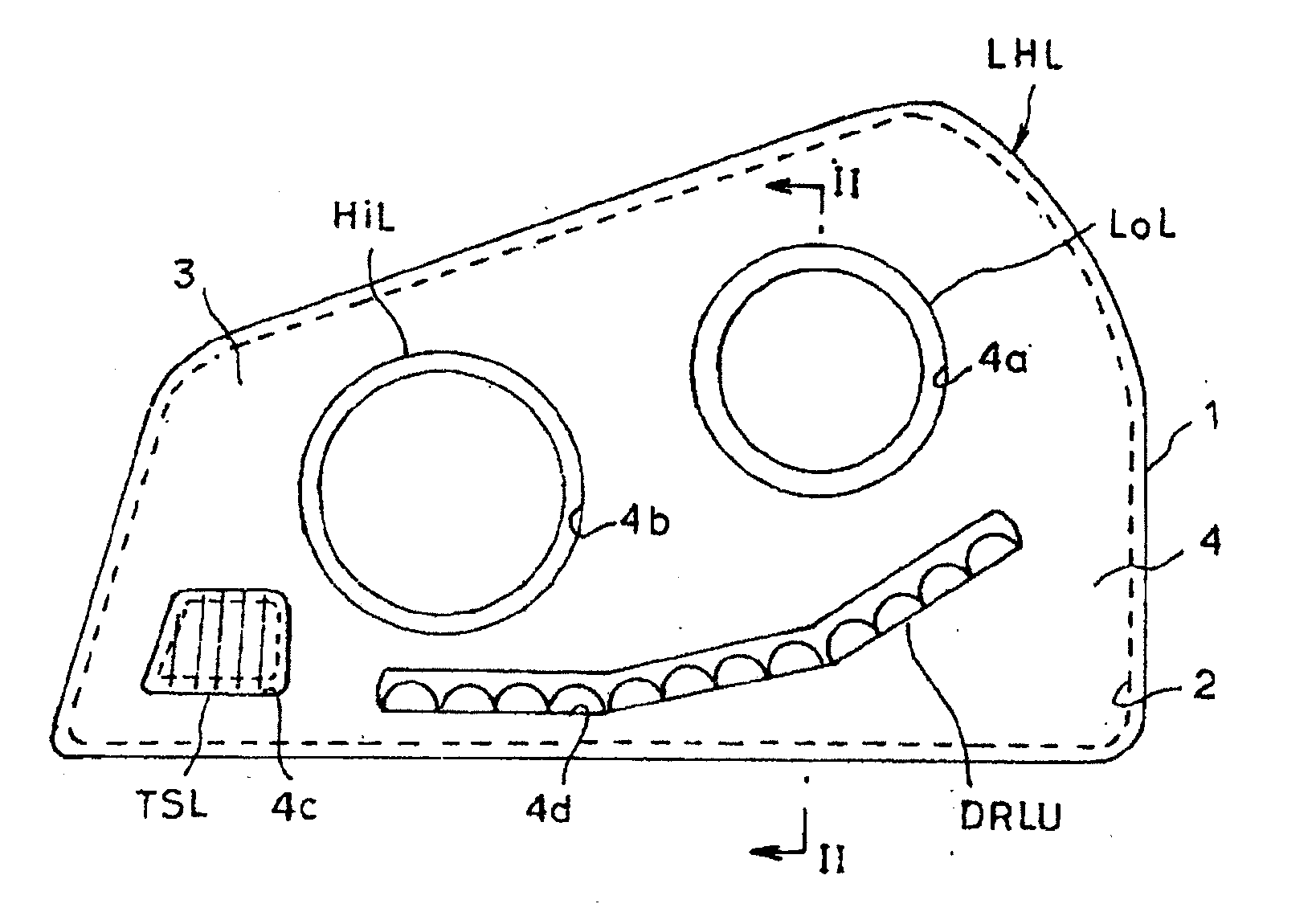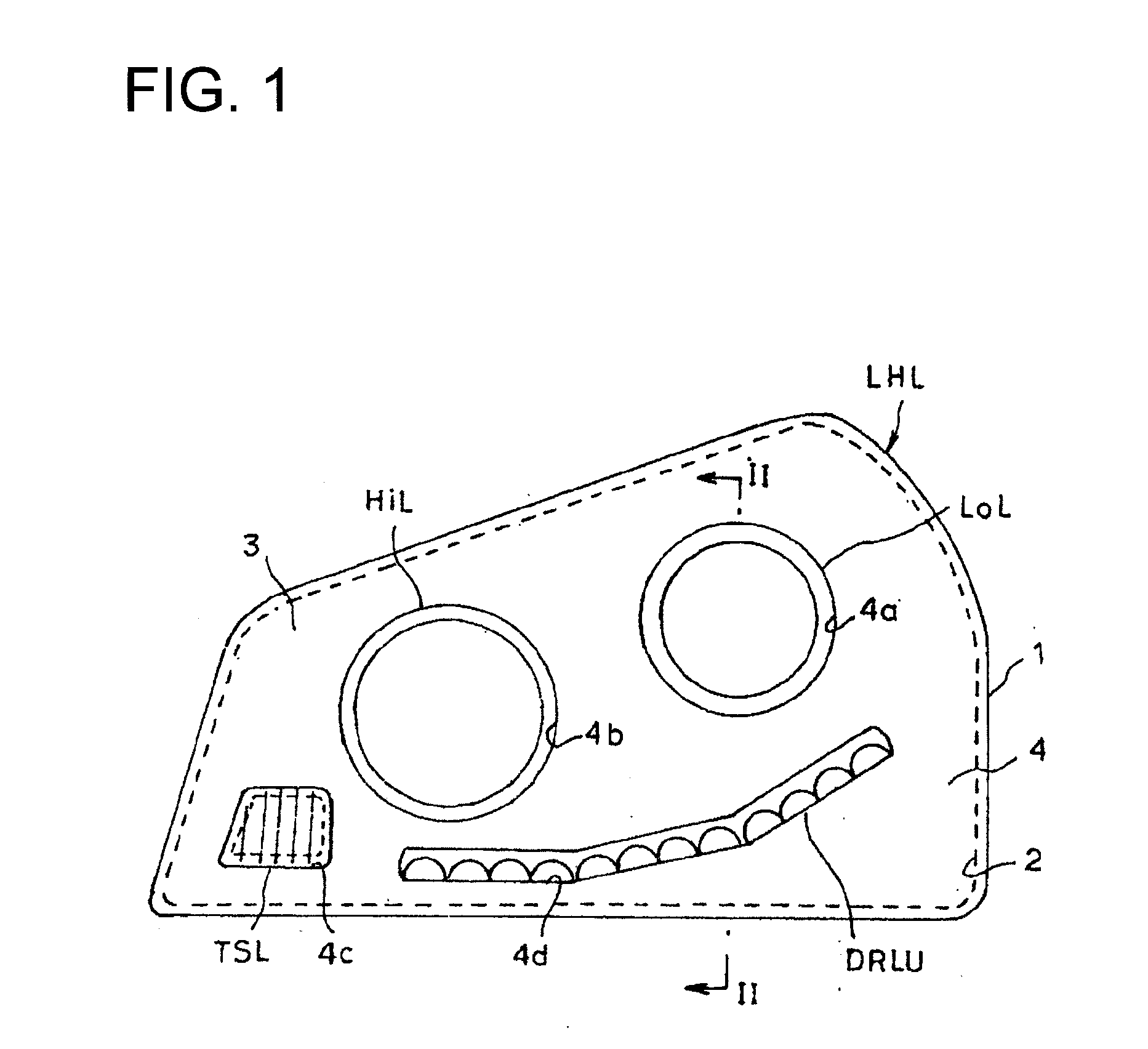Vehicular lamp
- Summary
- Abstract
- Description
- Claims
- Application Information
AI Technical Summary
Benefits of technology
Problems solved by technology
Method used
Image
Examples
first embodiment
[0025]Hereinafter, embodiments of the present invention will be described with reference to the accompanying drawings. FIG. 1 is a schematic frontal view of an embodiment of the present invention applied to a left headlamp LHL among headlamps provided on the right and left sides of a front body portion of an automobile. FIG. 2 is an enlarged cross-sectional view taken along a line II-II in FIG. 1. A lamp housing 1 is formed from a container-like lamp body 2 and a transparent front cover 3. A low-beam lamp LoL, a high-beam lamp HiL, and a turning signal lamp TSL are provided aligned inside the lamp housing 1, with the low-beam lamp LoL on the right side and the high-beam lamp HiL and the turning signal lamp TSL on the left side as viewed from the front. The low-beam lamp LoL and the high-beam lamp HiL may be formed from any type of lamp. In this embodiment, for example, the low-beam lamp LoL and the high-beam lamp HiL are formed from projector type lamps that use a discharge bulb or ...
second embodiment
[0042]FIG. 5 is a schematic perspective view of a DRL unit DRLU2 according to a second embodiment. Here, a base substrate 11A is formed with a planar shape having a narrow arc that curves along the curve of the front edge of the extension 4 or the lamp housing 1. The base substrate 11A is fixed to the rear inner surface of the lamp body 2 (similar to the embodiment shown in FIG. 2) by a reverse L-shaped support tab 11a that is provided at a plurality of locations in the length direction of the base substrate 11A. An FPC 13A is formed with a similar narrow arc corresponding to the base substrate 11A, and a plurality of LEDs 14 is mounted in the length direction of the FPC 13A. One base substrate 11A is used in the second embodiment, and this FPC 13A is adhered and fixed to a flat portion that accounts for almost the entire top surface of the base substrate 11A, with the plurality of LEDs 14 mounted on the FPC 13A. Specifically, four LEDs 14 are mounted so as to be similarly positione...
third embodiment
[0045]FIG. 6 is a cross-sectional view similar to FIG. 2 of a DRL unit DRLU3 according to a third embodiment. FIG. 7 is a schematic perspective view. Three base substrates 11B are each formed into an L-shape with the front edge portions formed bending vertically upward. A front edge portion 11b of each base substrate 11B is formed as a flat portion that is flat in the vertical direction, and the front edge portion 11b is provided inside the lamp housing 1 so as to be positioned behind the opening window 4d of the extension 4. In addition, a horizontally oriented rear edge portion 11c is fixed by a screw 19 (see FIG. 6) on a lower edge portion 4e that is bent toward the rear of the extension 4, and thereby integrated with the extension 4.
[0046]An FPC 13B, similar to the first embodiment, extends over three base substrates 11B. A front edge portion 11b of the base substrate 11B is vertically oriented. Using an adhesive, the FPC 13B is adhered to and integrated with the front edge port...
PUM
 Login to View More
Login to View More Abstract
Description
Claims
Application Information
 Login to View More
Login to View More - R&D
- Intellectual Property
- Life Sciences
- Materials
- Tech Scout
- Unparalleled Data Quality
- Higher Quality Content
- 60% Fewer Hallucinations
Browse by: Latest US Patents, China's latest patents, Technical Efficacy Thesaurus, Application Domain, Technology Topic, Popular Technical Reports.
© 2025 PatSnap. All rights reserved.Legal|Privacy policy|Modern Slavery Act Transparency Statement|Sitemap|About US| Contact US: help@patsnap.com



